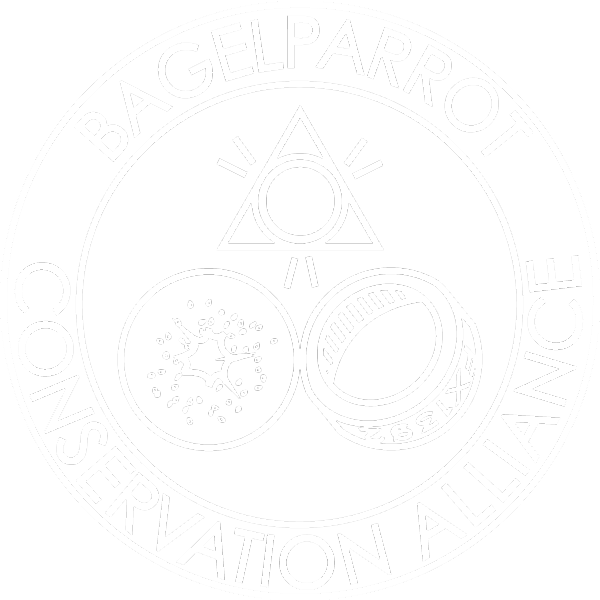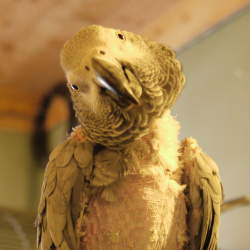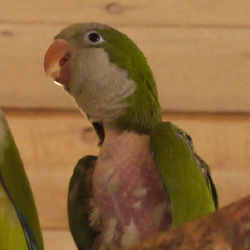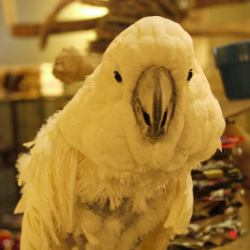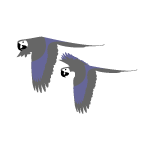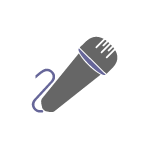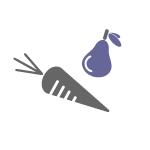“It is like keeping an elephant chained in your back yard. No one should think of sharing their lives with a parrot unless they can offer hours of companionship each day and provide a stimulating environment.”
PARROTS ARE NOT PETS
Parrots are social animals who fly in groups of up to thousands of birds, forming complex societies with families and hierarchies. As prey animals, they need a flock-like environment to feel safe. Most parrots are monogamous, and form strong pair bonds that last for life. A parrot in the wild is seldom alone; even when flying among their flocks, pairs always fly next to each other.
Stressed by life in captivity, many pet parrots pluck out their feathers and self-mutilate
In captivity, parrots are usually kept as a single bird so they bond with their owner. They are left alone the majority of the day when their owners are at work. Unable to adjust to social isolation and the physical confines of a home, many parrots pluck their feathers or self-mutilate, developing behavioral problems that are very difficult to correct. Parrots are so sensitive to their environment that any stressful event or abrupt change in routine – such as a death in the family, a move, a new baby – can trigger plucking. This is unheard of in the wild.
Prized for their intelligence, beauty, and mimicry, parrots have been extracted from forests to become caged pets for thousands of years; but the practice is not without controversy. Many people are unaware about the level of care and commitment required to raise a healthy and happy parrot. Because so many pet birds end up unwanted, we encourage those who are truly committed to adopt and not buy a bird.
Parrots are a lifelong commitment
In the United States, birds are the fourth most popular pet behind fish, dogs, and cats. The American Pet Products Association estimates there are 20.6 million pet birds in the US alone¹, and breeders continue to saturate the domestic market with 2 to 5 million baby birds every year². However, the issue is not centered around sheer populations statistics alone, but the number of qualified placement options. With many larger parrots having a lifespan of 40-100 years, they outlive any other pet by decades – and many outlive their owners. We are facing an epidemic of parrots needing homes.
The average parrot is passed through several homes during its lifetime
Parrots are now more common in captivity than in forests, and accordingly, the narrative has switched to regarding them as common household pets instead of endangered wild animals. There are thousands of videos online of parrots as cute, talking creatures; people buy them on impulse, unaware that they’re extremely demanding. Many soon find out that the cute, cuddly bird at the pet store now bites, screams, throws food everywhere, and likes only one person. Or that the bird can’t talk and do tricks. Now factor in a lifespan of 60+ years – and you have an animal being passed around several homes during his lifetime.
In the wild, parrots form bonds that last for life. Each time a parrot is passed to another home, his heart is broken; he eventually develops many behavioral problems such as feather-plucking, and becomes even more unwanted. These birds have become disposable “throwaway” pets; even with an existing overpopulation of rescue birds, however, the pet industry continues to saturate the domestic market with millions of baby birds a year.
Having a parrot is like having a toddler who never grows up
The intelligence of parrots rivals that of chimps, dolphins, and young children. Studies on Alex the parrot, who could verbally identify dozens of objects, colors, and even do math, proved that parrots have the cognitive ability of a 3 to 5-year-old child. Ironically, the publicity around their intelligence did them in – ultimately contributing to the African Grey parrot becoming one of the most heavily traded animals in the world and decimating their populations in the wild. People often realize too late, however, that an intelligent animal needs constant stimulation and enrichment – similar to a (perpetually) young child.
Buying a parrot is as easy as buying a loaf of bread. There are no laws or rules around it; anyone can walk into a pet store and buy an animal as intelligent as a 5-year-old. Groups such as the American Federation of Aviculture, which represents the interests of breeders, work extensively to fight any legislation that protects birds. In 1995, they opposed the renewal of the Wild Bird Conservation Act (banning imports of wild-caught birds); in 2002, they opposed a bill to add birds to the list of protected animals under the Animal Welfare Act³.
Parrots are wild animals
Still think you’re ready for a parrot?
Adopt a parrot from a local reputable sanctuary and break the cycle of commercial profit from the pet trade.
“Pet Industry Market Size & Ownership Statistics.” American Pet Products Association. Web. 11 June 2014.
Windsor, Karen. “Overpopulation of Parrots and the Expanding Unwanted Parrot Crisis.” Foster Parrots, Ltd, 2013. Web. 27 May 2014.
“Conservation of Birds in the Wild.” Born Free USA. Web. 2 May 2014.
